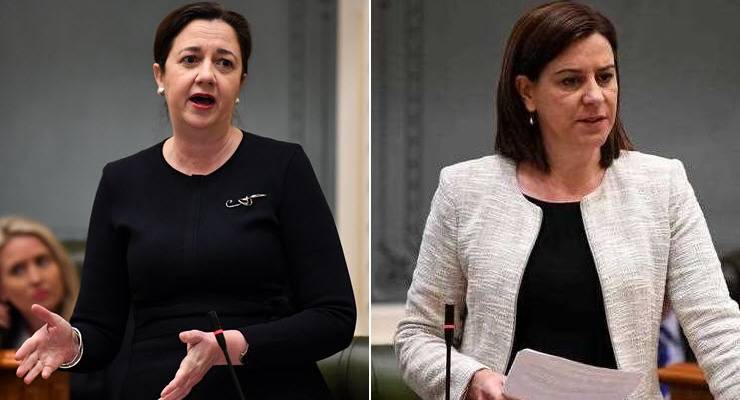
October’s state election will mark the first time Queenslanders have been asked to determine who should govern since the state introduced set four-year terms. In a state of traditions, that will take time to bed in our psyche.
Another tradition up for grabs in this poll is that Queensland voters have, for most of the past 30 years, elected state Labor governments while giving the conservatives the federal seats they need to run the country.
This will be the 12th election since Queenslanders last had the chance to vote for the folk hero of conservative politics, Sir Joh Bjelke-Petersen. They have only elected a conservative government, run by Campbell Newman, in one of them and it was sent packing in an electoral drubbing after just one term.
In that same period, voters have gone home strongly and sometimes overwhelmingly with John Howard, Tony Abbott, Malcolm Turnbull and Scott Morrison at a federal level (the exception was the Rudd-slide in 2007).
This bifurcation is one of those curious traditions of Queensland politics. Part of Labor’s success at a state level it is to do with the regional nature of the state. Big centres outside of Brisbane — like Cairns, Townsville, Rockhampton and Mackay — are big enough to matter in the seat count and have urban characteristics that attract their voters to the ALP.
There’s also the grenade permanently planted in the conservative knapsack by Bjelke-Petersen, who blew up the possibility of conservative Coalition governments by rebranding the Country Party as the National Party and bringing it into the city. A unified conservative party was the result but it still needs to straddle both urban and regional interests in a way that has so far defeated it.
The reality is that it’s almost impossible to win state government in Queensland without a solid regional showing, but it’s actually impossible to win without dominating Brisbane. The “National” side of the LNP needs to bring home the regions, with the “Liberal” side needing to deliver the city.
One other ingredient is needed to succeed: a team, and a leader, that can convince voters they’re up to the job. That’s where the “Liberal” side has failed. This is due to its emphasis on holding national government and a readiness to sacrifice the state house by sending its best people to Canberra.
The Queensland conservatives have sent a squadron of their best lieutenants to Canberra over the past 20 years — Peter Dutton, Ian Macfarlane, Karen Andrews, Steven Ciobo, George Brandis, Warren Entsch and Ted O’Brien among them. That means a weaker team here, with a leadership vacuum.
Then there’s the other factor: the malcontents. Whether it’s One Nation, the Katter Australia Party, Clive Palmer’s various vehicles or even the old Confederate Action Party, there will always be a grassroots force leaching votes away from the LNP in regional Queensland. Without a term or two in government to demonstrate support for the bush, the conservatives will increasingly carry the label of being a city party.
This election promises more of the same. One likely outcome is that the LNP will be able to form government with the support of cross benchers led by Robbie Katter, whose members will represent seats that were solidly conservative and still are federally. But even his support is no certainty.
And that makes the quadrennial Queensland election a suitable curtain raiser to another event fixed in the calendar: the Melbourne Cup, where it’s always hard to pick a winner in a field of roughies and blue bloods.








It still breaks my heart to see Madonna King writing for Crikey.
The real issue in the Queensland election is whether or not the Murdoch Press can do enough damage to bring Labour down.
Clive Palmer chipping in with his double page spreads won’t help either.
The LNP being divided helps Labour and Anastasia deserves another term for keeping her nerve on COVID.
Don Neil
Ummm….”Queensland conservatives have sent a squadron of their best lieutenants to Canberra” …Peter Dutton? LOL 10/10 for having a lend Madonna. 🙂
“Queensland conservatives … best lieutenants ” – that’s about right, but she could have included Senator Jethro Joyce.
Sorry klewso, we managed to get Jethro to return to his roots.
I suppose I could rephrase that, but whatever.
“The Queensland conservatives have sent a squadron of their best lieutenants to Canberra over the past 20 years — Peter Dutton, Ian Macfarlane, Karen Andrews, Steven Ciobo, George Brandis…”
Hahahahaha haha hahaha
Indeed, Marcus! You would have to laugh, because otherwise there is only crying left!!
“Best in Show”? How do you judge that – with one closed?
Brandis, Dutton and Macfarlane what a trio of “best lieutenants”?
Dutton is Dutton.
Ian “DIY” Macfarlane gets given a “fake Rolex watch” (by a Chinese noodle billionaire) and prices it himself (for the purposes of register of gifts) from Google at “$400” – if he’d taken it to a real “professional” (who knew what they were doing – before Goodenough saw it) they could have told him it was worth $40,000?
“Bookshelf” Brandis? …. Those letters from Man Monis? “Weddings, Parties, Anything” (including going to Michael Smith’s NSW wedding – with Jethro) = “parliamentary business”?
If only Qld had been able to keep them for our parliament????
She “forgets” Santo Santoro? Ian MacDonald? Jethro Joyce? Keith Pitt?
George “Ping-pong” Christensen? Stewie Robert? It goes on.
““Best in Show”? How do you judge that – with one eye closed? …”
Just about to say the same!
Well if they are all in a pig pen and covered in mud, then the one with both his trotters in the trough must come first and his head does look just like some of those policemen we jailed back after the Joh era.
A couple of the others looked remarkably like the Joh era ministers we jailed too!
Very pleasingly, I must say.
If only it were that easy? If only King-Fagan was still employed to churn out PR for Rupert’s Limited News Party for Rupert’s Curry or Maul – trying to influence voter perception as to “fitness to govern” : to influence election outcomes?
Undeniable. She’s trotted out the same rubbish on ABC radio for 20 years too. She’s a degenerate and hopefully Crikey loses more subscriptions due to her garbage so they wake up to themselves.
The ABC (radio) – “That citadel of leftie ideology” as the alt-right finds an immeasurable quantum of solace in believing.
I think you missed her point Klewso, that ugly bunch of misfits were indeed their best and brightest.
Sadly still not quite corrupt or dumb enough to star in the LNP Rorts team.
For years her “point” was that her “Limited News Party does things better”.
“a readiness to sacrifice the state house by sending its best people to Canberra.“
This line had me laughing, the roll call had me in stitches. What a bunch of malcontents, as strong an argument that the meritocracy doesn’t exist as any I could muster. Hilarious.
Unsubscribe until they give King the boot that she deserves, it’s the only way to get things done.
It is truly horrifying that Murdoch owned press is the only thing available easily in Qld. The courier mail is a rag, in every way. Very obvious that the knives are out for the premier. Jo Bjelke Peterson still reigns in qld . The further north you go from Brisbane, the worse it gets. He infected everything with his “don’t you worry about that” dictum to everything.
Creationism was taught in schools as science……….Madonna King, you speak through your arse.
Madonna might be employed by Crikey for short term laughs, until they find their new resident satirist….